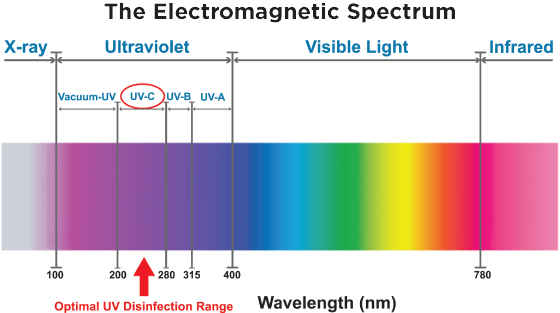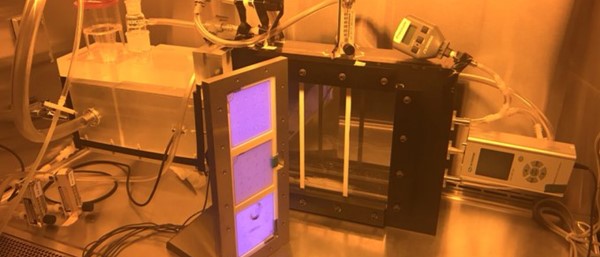ARTICLE – I stumbled upon an interesting crowdfunding campaign while researching the germicidal effects of ultraviolet type-C light for my PhoneSoap Go review (review coming soon). The Center for Radiological Research (CRR) at Columbia University Irving Medical Center (CUIMC) is conducting a campaign to raise money to perform studies that will help determine how effective far-UVC light is in inactivateing the virus that causes COVID-19 disease (the virus is called severe acute respiratory syndrome coronavirus 2 or SARS-CoV-2 according to the World Health Organization).
Researchers are trying to raise $50,000 and currently have $25.195 If they raise the money, they can immediately start their research, and if far-UVC is found to be effective, it “could be deployed in schools, airports, train stations, airplanes, hospitals – anywhere people congregate, to limit the spread of COVID-19 and other respiratory diseases” (crowdfund.columbia.edu). This would be a way to “curtail not only COVID-19 now, but future super-viruses as well as more familiar viruses like influenza and measles” (crowdfund.columbia.edu).
 So, you might have some questions like, “How does far-UVC light kill germs?” “But first, what is UVC?” “What is far-UVC?” “And what specifically are germs?”
So, you might have some questions like, “How does far-UVC light kill germs?” “But first, what is UVC?” “What is far-UVC?” “And what specifically are germs?”
First of all, what is UVC light? UVC light is a portion of the ultraviolet light spectrum just like UVA or UVB (see diagram above). UVC light (200-280) has long been known to kill disease-causing microorganisms (sciencemag.org). However, it cannot be used around humans because it can cause skin cancer and cataracts. Normally, UVC light from the sun is completely filtered out by Earth’s ozone layer (fda.gov) and thus does not get the chance to cause us any harm. Manufactured conventional germicidal UVC light sources use the 254 nm wavelength to disinfect, though not when humans are present.
What is far-UVC? This is a portion of UVC light that is in the range of 207-222 nm (nature.com). Far-UVC can still disinfect objects as well as the air around us by penetrating through to the genetic material of microbes and disrupting the bonds that hold the genetic material together thus prohibiting replication. However, it does not penetrate the outer dead layer of skin cells that cover our bodies, nor does it penetrate the tear layer covering the eyes (cuimc.columbia.edu); thus, far-UVC can’t cause skin cancer or cataracts. Simply put, it’s safe for humans but kills germs.
What are germs? The term “germs” generally includes bacteria, viruses, fungi, and protozoa. Some germs are bad for you but many are beneficial. Each of these organisms is very different from the other and thus reside in different kingdoms when classifying them, but there are a few similarities among some of them. Bacteria, fungi, and protozoa can replicate by themselves and do not need a host to survive. Bacteria and protozoa are single-celled organisms while fungi can be single-celled or multicellular. We use antibiotics to kill bacterial infections, antifungal medicines to kill fungal infections, and other drugs to kill protozoan infections (e.g. malaria).
Viruses are not living things at all. They are genetic material (DNA or RNA) wrapped in a protective coating and need a host to replicate. They get inside the host’s cell and direct the cell’s machinery to make copies of the virus. Antiviral medicines only prevent viruses from replicating – they do not “kill” or get rid of the virus in your body. Vaccines “train the immune system to recognize and combat pathogens” (papersowl.com) so that your body recognizes the invader and attacks it before it causes illness.
In 2018, Columbia researchers demonstrated that far-UVC inactivated a common strain of the flu virus “with about the same efficiency as conventional germicidal UV light” (cuimc.columbia.edu). So, if Columbia University researchers find that far-UVC is effective against the virus that causes COVID-19 as they did with a common strain of the flu virus, then it can be implemented quickly to help curtail the spread of COVID-19. If you are interested in helping to fund their research, please visit the Columbia University crowdfunding webpage.




Gadgeteer Comment Policy - Please read before commenting
COLUMBIA is using a foreign companies lamp. That company refuses to license our Patented Technology. We will defend our Patents. COLUMBIA does not have any products. We have products that can save thousands of lives! They are taking money that we could use to ramp up production!
Please visit our campaign gf.me/u/xarzzv
Listen to the real inventor of Excimer Wave Sterilray 222nm light
Ed Neister-Physicist and Patent Holder of Excimer Wave Sterilray™ interview on Rock 100.5 Atlanta 3/26/2020
https://omny.fm/shows/bailey-and-southside-podcast/interview-with-inventor-and-physicist-ed-neister#sharing
After further review.
This is Columbia not the person that has a goFundMe campaign that is a SCAM. We are asking GoFundMe to take that down.
Columbia wants to do research with a competitors lamp to prove our patented technology can destroy COVID-19. Works for us! However, should the foreign company then try to sell lamps for disinfection of air, surfaces, liquids, skin or eyes, we will take them to court. We have people waiting to do so.
We have 2322nm Excimer Wave Sterilray products to sell now!
We can save thousands of lives long before this research is done.
We have proof we destroy this Virus. Contact us!
Government is not helping us to ramp up yet money went to research sunscreen!
Please consider giving to our legitimate campaign.
gf.me/u/xarzzv
visit http://www.sterilray.com for more information.
John Neister – I really hope you are successful in getting those lamps out there to combat the spread of COVID-19, super-bugs, and any future new pathogens. We need these far-UVC lamps as well as vaccines, and other treatments/prevention methods!
Thank you for letting me know it was a scam. I was going to donate, and am glad I found this out. I’m a single mom of 3 and any money I spend has to make sense. Thanks for making me aware. God bless and stay safe.
JOHN NEISTER, I donated to your GoFundMe. I know 15.00 isn’t much, but I wanted to support you. I’m so Leary of buying any products that claim protection, because I have to trust the products eork. I’ve done a lot of research looking for what to buy battling this virus, and Sterilray is the one I am trusting. Stay safe and good luck.
Note there is a typo in my last comment. IT SHOULD READ
222nm instead of 2322! Please make that correction before you post!
If UVC (between 200-280 nm) can cause skin cancer and this lamp is between 207-222 nm, the lamp is within the range that causes cancer. In fact, it is on the shorter wavelength (higher energy) portion of UVC, so should be more cancerous. Perhaps the intent was to use this lamp on non-living surfaces?
Higher photon energy but does not penetrate. Please read our website on skin to explain! We are treating eyes of patients! Moving to FDA approval. All UV is not the same as different as Red and Blue. http://www.sterilray.com
John Kes – Since I am not an expert in this field, I cannot speak to the science behind why far-UVC does not penetrate through skin or the tear layer of the eyes. However, here is what an expert stated about far-UVC:
“David J. Brenner, PhD, the Higgins Professor of Radiation Biophysics at the Vagelos College of Physicians and Surgeons and director of the Center for Radiological Research at Columbia stated:
‘Far-UVC light has a very limited range and cannot penetrate through the outer dead-cell layer of human skin or the tear layer in the eye, so it’s not a human health hazard. But because viruses and bacteria are much smaller than human cells, far-UVC light can reach their DNA and kill them,’ said Brenner, who is also a professor of environmental health sciences at Columbia’s Mailman School of Public Health.”
He may not have explained why or how this happens, but I trust he knows what he is saying. Since it does not penetrate through to our living tissues, it would thus be safe to use around human beings to disinfect surfaces as well as the air around us.
“This experimental approach and the related data on its own is nowhere near rigorous enough to support a claim that Far-UV Sterilray™ exposure of human skin is ‘safe’” From skin report on sterilray(tm) website. The Brenner guy you quoted is with Columbia, apparently Sterilray(tm) nemesis. But Brenner has done research on human effects of the 222nm light almost in parallel with Neister. No one is going to have their kids walk under these lights without the science to prove it’s safe. It’s too bad they couldn’t work together but on the other hand it’s probably good that a credible science report is from a group not working hand in hand with the manufacturer. Neister should be rewarded but not at the cost of the human race and someone should ask Brenner or Columbia why they are working with a foreign based manufacture over a US company that owns the patent. If it’s Neister’s technology then lets pay the guy and get the damn things out on the street!
Michelle Whalen – Columbia University is an Ivy League school located in New York – my brother, a doctor, attended that school. I contacted the University directly today to verify that this was an authentic research endeavor and it is indeed a legitimate fundraising campaign. It complements the funding from government sources and other donors.
Mr. Neister had mistaken this crowdfunding campaign for another, which he stated in additional comment on this post.
I understand your wariness about where to donate your money – you truly want it to go to places where it will do the most good. I do too, especially during this time when scammers are ubiquitous. Knowing that this crowdfunding campaign was being conducted by a renowned institution helped me to feel confident that this research was something that was worthwhile for our readers to fund.